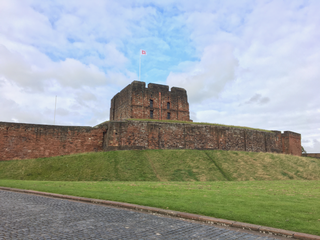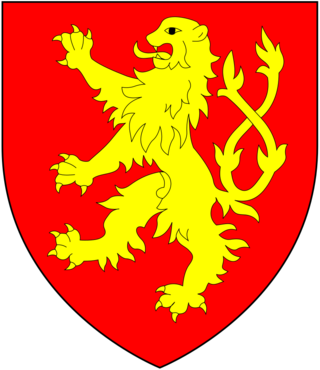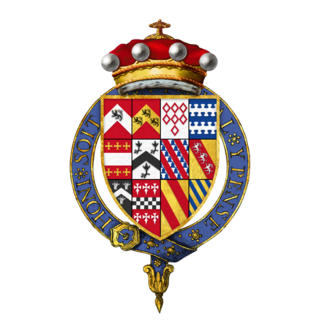Peter II, called the Little Charlemagne, was Count of Savoy from 1263 until his death in 1268. He was also holder of the Honour of Richmond, Yorkshire, England, the Honour of the Eagle also known as the Honour of Pevensey and the Honour of Eu also known as the Honour of Hastings. His significant land holdings in Sussex were also marked by his holding of the wardship of John de Warenne, 6th Earl of Surrey which brought with it lands centred upon Lewes castle. Briefly, from 1241 until 1242, castellan of Dover Castle and Keeper of the Coast. In 1243 he was granted land by the Thames in London where he later built the Savoy Palace.

Carlisle Castle is a stone keep medieval fortress located in the city of Carlisle near the ruins of Hadrian's Wall. First built during the reign of William II in 1092 and rebuilt in stone under Henry I in 1122, the castle is over 930 years old and has been the scene of many episodes in British history.
Hamo de Crevequer was an Anglo-Norman nobleman who held the office of Lord Warden of the Cinque Ports.

Stephen de Pencester was Warden of the Cinque Ports when the first authoritative list of Cinque Ports Confederation Members was produced in 1293.

Sir Roger de Leybourne (1215–1271) was an English soldier, landowner and royal servant during the Second Barons' War.

Bartholomew Burghersh, 1st Baron Burghersh, called "the elder", was an English nobleman and soldier, a younger son of Robert Burghersh, 1st Baron Burghersh and Maud Badlesmere, sister of Bartholomew Badlesmere, 1st Baron Badlesmere. He was the father of Bartholomew Burghersh the younger.

Sir William Brooke, 10th Baron Cobham, KG, lord of the Manor of Cobham, Kent, was Lord Warden of the Cinque Ports, and a member of parliament for Hythe. Although he was viewed by some as a religious radical during the Somerset Protectorate, he entertained Queen Elizabeth I of England at Cobham Hall in 1559, signalling his acceptance of the moderate regime.

Henry Brooke, 11th Baron Cobham KG (22 November 1564 – 24 January 1618 /3 February 1618, lord of the Manor of Cobham, Kent, was an English peer who was implicated in the Main Plot against the rule of James I of England.
Sir Bertram de Criol was a senior and trusted Steward and diplomat to King Henry III. He served as Constable and Keeper of Dover Castle, Keeper of the Coast and of the Cinque Ports, Keeper of the receipts, expenses and wardships of the archbishopric of Canterbury, Constable of the Tower of London and Sheriff of Kent.
Walerand Teutonicus was a Lord Warden of the Cinque Ports during the thirteenth century.

Nicholas de Crioll, of a family seated in Kent, was Constable of Dover Castle and Keeper of the Coast during the early 1260s. His kinsman Bertram de Criol had distinguished himself in these offices during the preceding 20 years and both were near predecessors of the eminent Warden of the Cinque Ports, Stephen de Pencester.
In English law, the justices in eyre were the highest magistrates, and presided over the court of justice-seat, a triennial court held to punish offenders against the forest law and enquire into the state of the forest and its officers.
There has been a Lord Lieutenant of Buckinghamshire almost continuously since the position was created by King Henry VIII in 1535. The only exception to this was the English Civil War and English Interregnum between 1643 and 1660 when there was no king to support the Lieutenancy. The following list consists of all known holders of the position: earlier records have been lost and so a complete list is not possible. Since 1702, all Lord Lieutenants have also been Custos Rotulorum of Buckinghamshire.
Events from the 1260s in England.

The Cinque Ports Fleet was the a temporary formation of ships supplied to the crown from the Confederation of the Cinque Ports for particular naval expeditions during particular campaigns of the Kingdom of England from 1260 to 1558.

Robert Walerand, was Justiciar to King Henry III (1216–1272). He was throughout his reign one of the king's familiares. Among the king's household knights he stands in the same position as his friend John Mansel among the royal clerks. Walerand was most notably employed by the king in the ill-fated scheme of raising money from the barons for his second son Edmund to take up the crown of Sicily, offered by the Pope in 1254. His forceful exactions in that connection were one of the causes of the rebellion of Simon de Montfort and the Barons' War, which ended however with royal victory at the Battle of Evesham in 1265. His principal residence was Siston, Gloucestershire.

The Governor of Rochester Castle commanded the important castle at Rochester in Kent, England which dominated the Medway estuary and Watling Street. After being badly damaged during the Barons' Wars the castle was completely renovated by King Henry III and put under the control of a series of Governors responsible for its upkeep and security.

The title Baron Cobham has been created numerous times in the Peerage of England; often multiple creations have been extant simultaneously, especially in the fourteenth century.











